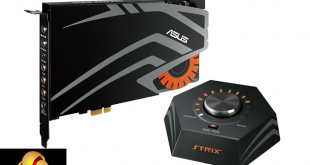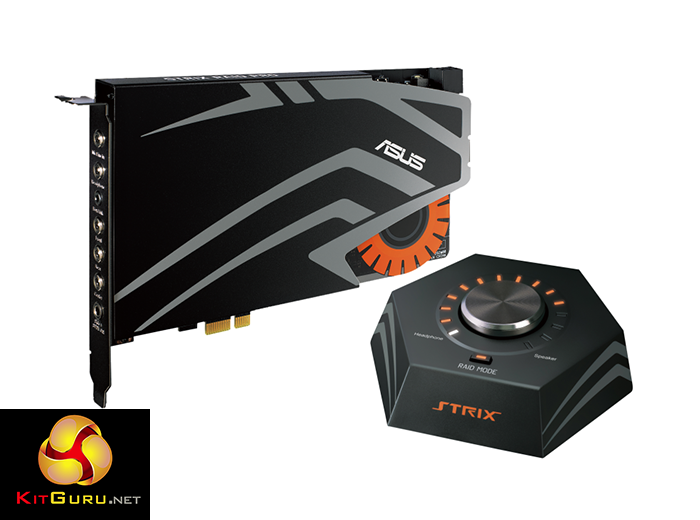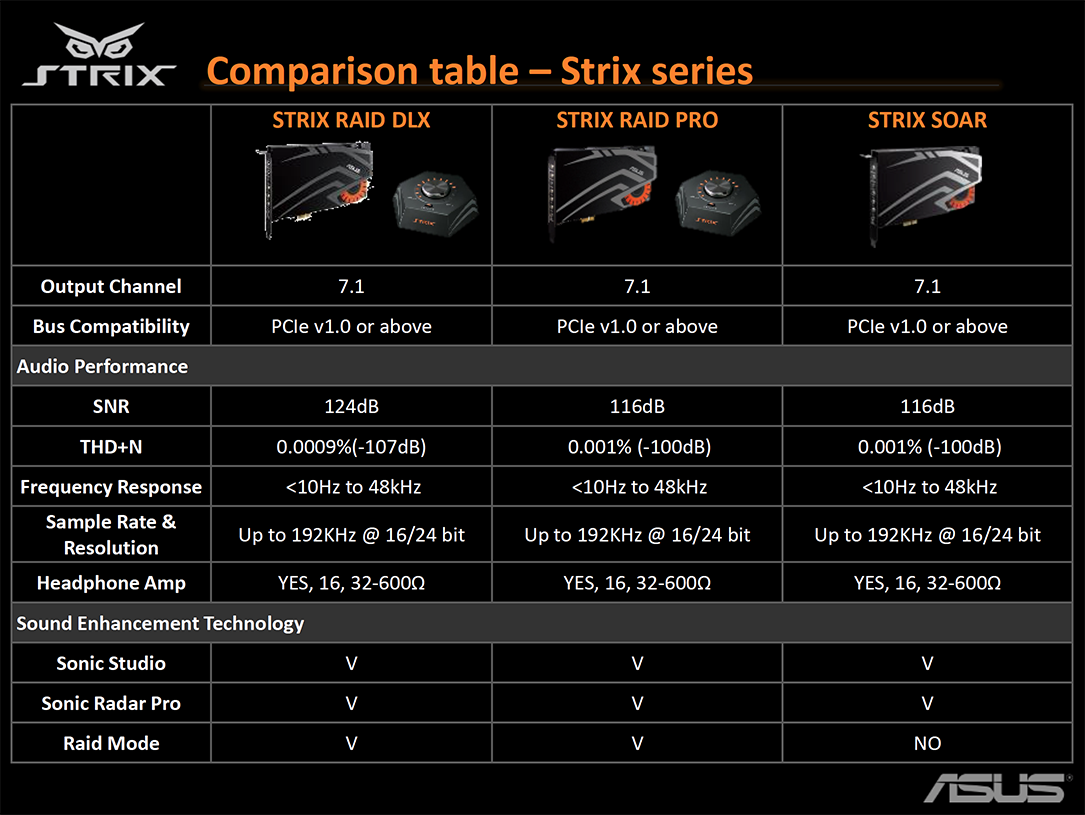
If you take audio seriously then the onboard processing on many motherboards simply wont deliver an immersive enough experience. Today we look at the mid range solution in the new range from ASUS – dubbed the Strix RAID Pro. This card has full support for 7.1 surround sound. Asus have adopted an ‘audiophile grade DAC' and a 600 ohm headphone amplifier to enhance audio reproduction through your favourite cans.

Initially I thought the word ‘RAID' in the product name may have had something to do with storage or installing the sound cards in multiple configurations – but we can put that theory to bed now. It appears to have more of an association with gamers, who like to ‘RAID' – that being a number of people attempting to defeat a boss monster or consecutive series of bosses.
Silly names aside, the technical aspects of the hardware are certainly not lacking, especially when factoring in the modest £99.95 asking price.

Being somewhat obsessed with audio equipment I do own quite a few pair of high grade headphones so it was with great interest that I noticed ASUS have incorporated a dedicated headphone amplifier into this sound card. Asus quote ‘up to 600 ohm' which should make it a good partner for many headphones, including 300 ohm and 600 ohm models from Sennheiser and Beyerdynamic. My own pair of first revision Beyerdynamic T1 are actually rated at 600 ohm.
Our focus today on the ASUS Strix RAID Pro 7.1 will be the first of three reviews we will be publishing over the coming weeks – this particular sound card slots in between the Strix SOAR entry level model and the Strix Raid DLX flagship sound card.
ASUS Strix RAID Pro 7.1 PCI-E Specifications:-
- Audio Interface- PCI Express.
- Output Signal-to-Noise Ratio (A-Weighted) (Front-out) : 116 dB.
- Output Signal-to-Noise Ratio (A-Weighted) (Headphone-out) : 110 dB.
- Input Signal-to-Noise Ratio (A-Weighted) : 110 dB.
- Output THD+N at 1kHz (Front-out) : 0.001 %(-100 dB).
- Output THD+N at 1kHz (Headphone-out) : 0.003 %(-90 dB).
- Input THD+N at 1kHz : 0.000316 %(-110 dB).
- Frequency Response (-3dB, 24bit/96KHz input) : 10 Hz to 48 KHz.
- Output/Input Full-Scale Voltage : Line output (RCA, 3.5) : 2 Vrms (5.65 Vp-p).
- Audio Processor :C-Media USB2.0 6632AX High-Definition Sound Processor (Max. 384KHz / 24bit).
- Digital-to-analog Converter(DAC) ESS SABRE9006A Premier 8 Channel Audio DAC.
- Analog Playback Sample Rate and Resolution : 44.1K/48K/88.2K/96K/176.4K/192KHz @ 16bit/24bit.
- Analog Recording Sample Rate and Resolution : 44.1K/48K/88.2K/96K/176.4K/192KHz @ 16bit/24bit.
- S/PDIF Digital Output : 44.1K/48K/96K/192KHz @ 16bit/24bit.
- ASIO 2.0 Driver Support : 44.1K/48K/96K/192KHz @ 16bit/24bit with very low latency.
 KitGuru KitGuru.net – Tech News | Hardware News | Hardware Reviews | IOS | Mobile | Gaming | Graphics Cards
KitGuru KitGuru.net – Tech News | Hardware News | Hardware Reviews | IOS | Mobile | Gaming | Graphics Cards



I received this card yesterday and installed all the necessary components. This review did not cover speaker performance one bit which is a major failure in this card as it sounds terrible with my analog 5.1 setup!
Probably the biggest let downs for analog speaker use is: 1 – there is no LFE subwoofer control, therefore my klipsch R110SW is being forced to output bass incorrectly leaving a huge frequency gap in the 120-200hz range.
2 – no dolby upmix packages are included for analog speaker outputs, the inbuily upmix sounds narrow and terrible.
Even the best onboard audio solution have no subwoofer control , your expectation well exceed reality.
Beside that this card is focusing on gamer market , over 90% of their analog speaker setup is a pair of front speakers.
Yeah but that’s onboard audio, for something that you’re paying extra for then I’d expect to have control over these features.
True but again I’d still expect to see it at this price point.
Quick question, is the virtual surround a “real” surround trick? And by that i mean, does it fool windows into thinking that there’s actually a 7.1 system plugged in or is it a simple stereo expand?
What I fiend weird is that Asus uses a USB2.0 audio chip together with a PCIe to USB converter. So essentially this is an internal USB Audio card. Because there are enough PCIe audio chips available, the only reason I can think of is that Asus wanted to cut down driver development and with this solution they can use the same driver for internal and external cards. I agree with Bulletlol that not having a LFE subwoofer frequency control is a let down for a product at this price.
Com on man, my ancient Asus P6T motherboard has a 10 band equalizer! What is with this limiting 8 band equalizer on this soundcard!?
lol, if the 8 band isnt able to correct for room/speakers/setup, the 10 wont either.
I don’t use the EQ to correct the audio for the room, I use the EQ to correct the audio to suit my taste, this is especially true since I wear headphones more than I use desktop speakers.
No difference.
Good cans will only need improvement on low or high frequency, if they need more than that, not really good headphones.
Unless we are talking about cans in the +800$ range where sometimes you have to compromise a little to get the better overall experience.
Then again, i don’t know anyone that spend more than 500 on cans/speakers, and doesnt use a +200$ card, which allow for swapping components to adjust the sound, hence limiting the need for additional equalization…